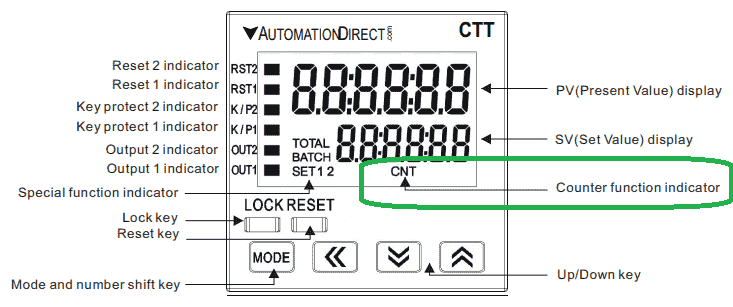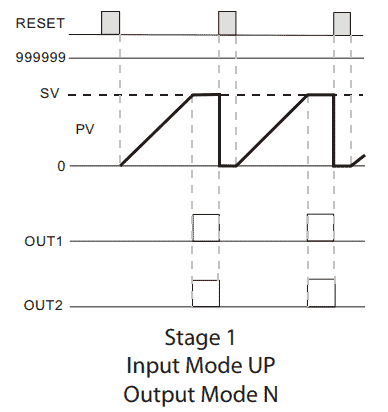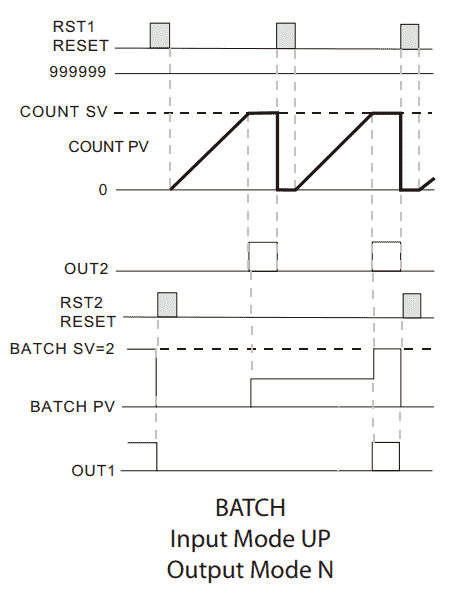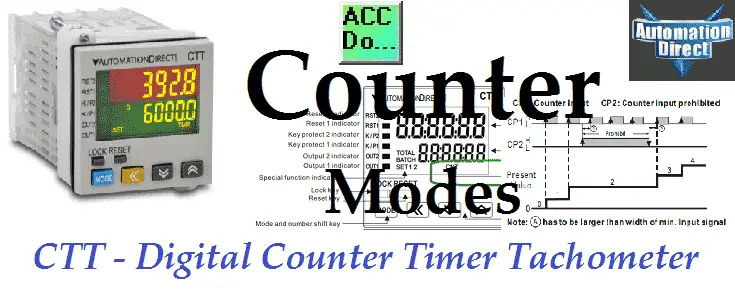The CTT series from Automation Direct are multi-function digital units. They incorporate a multi-function digital counter, timer and tachometer all within the same unit. The counter mode will operate in five (5) different ways. Up to five different count input modes can be selected. Up, Down, UP/Command Counting Down (UdA), UP/Counting Down (UdC) and Quadrature (UdC) can be selected. We also have a number of output modes to select so this unit can adapt to a great number of applications.

We will be looking at each of the Counter modes using the Up count input on this versatile digital unit. 1-Stage, 2-Stage, Batch, Total and Dual are the modes. Let’s get started.
Previously in this CTT Series – Counter / Timer / Tachometer we have discussed;
– CTT Counter Timer Tachometer – Getting Started
o Un-boxing the CTT Video
o Powering up the Unit Video
– CTT Timer Modes
o Signal On Delay 1 Timer
o Signal On Delay 2 Timer
o Signal Off Delay Timer
o Signal On Timer
o Power On Delay Timer
o Power On Delay Hold Timer
o Repeat Cycle Timer
o Repeat Cycle Hold Timer
o Repeat Cycle 2 Timer
o Signal Cumulate Timer
o Signal Twin On Start Timer
o Signal Twin Off Start Timer
All counter applications begin with a timing chart. The secret of using counters is a good place to start for a review of how timing charts work.
Programming these units can look like a hard task. The manual is over 260 pages! However there is an easy way. The manual is broken up into chapters for each of the operation modes of the CTT. (Counter, Timer, Timer + Counter, Tachometer)
Once we find our operation mode, you look for the timing chart mode for your application. The manual includes all of the information that you need for that mode. This includes wiring diagrams, timing charts, program steps and dip switch settings.
Example –Stage 1 Counting Up counter mode – Page 2-5 and 2-8 contain all of the information needed to program this mode.
Counting Up Mode – CTT
All of our sample programs will use the counting up input mode.

With the input signal OFF at input CP2, each leading edge of the input signal at CP1 will increment the count present value PV by 1. Turning ON the input signal at CP2, will prohibit the input signal at CP1 from incrementing the PV.
With the input signal ON at input CP1, each trailing edge of the input signal at CP2 will increment the count present value PV by 1. Turning OFF the input signal at CP1, will prohibit the input signal at CP2 from incrementing the PV.
Stage 1 Counting – CTT Counter Modes
A single count setting value SV is available in 1-Stage Counting. Both Outputs 1 and 2 operate concurrently and will turn ON momentarily or will be maintained ON depending on the Output Mode selected.

Watch on YouTube : CTT Stage 1 Counting
Stage 2 Counting – CTT Counter Modes
In 2-Stage Counting, count setting value SV1 controls Output 1 and count setting value SV2 controls Output 2. Outputs will turn ON momentarily or will be maintained ON depending on the output mode selected.

Watch on YouTube : CTT Stage 2 Counting
Batch Counting – CTT Counter Modes
In Batch Counting, count setting value SV controls Output 2 which will turn ON momentarily or will be maintained ON depending on the output mode selected. Count setting value BATCH SV controls Output 1which will be maintained ON.

Watch on YouTube : CTT Batch Counting
Total Counting – CTT Counter Modes
A single count setting value SV is available in Total Counting. Both Outputs 1 and 2 operate concurrently and will turn ON momentarily or will be maintained ON depending on the Output Mode selected.

Watch on YouTube : CTT Total Counting
Dual Counting – CTT Counter Modes
A single count setting value SV is available in Dual Counting. Both Outputs 1 and 2 operate concurrently and will turn ON momentarily or will be maintained ON depending on the Output Mode selected

Watch on YouTube : CTT Dual Counting
Summary of features – CTT Counter Timer Tachometer
– Can operate as a digital counter, timer, combination timer + counter, or tachometer
– Accepts voltage and non-voltage inputs from a wide variety of NPN, PNP, or dry contact sensors
– Selectable counting speeds from 1 to 10,000 cycles per second
– Multiple transistors and relay outputs can operate as momentary or maintained
– Double-line, 6-digit, 2-color LCD display
– Easy configuration with externally accessible DIP switches or the lockable keypad
– Display decimal point selection
– Available in 100-240VAC and 24VDC powered models
– UL508 listed (E311366), cULus, CE marked
Counter, Timer, Tachometer – CTT Series from Automation Direct
Shop Multi-Function Digital Counter / Timer / Tachometer
CTT Overview
https://cdn.automationdirect.com/static/specs/cttcountertimertachoverview.pdf
CTT Quick Start Guide
https://cdn.automationdirect.com/static/manuals/cttqsg/cttseries_qsg.pdf
Digital CTT Manual
https://cdn.automationdirect.com/static/manuals/digitalctt/digitalctt.html
Rhino Power Supply
https://www.automationdirect.com/adc/Overview/Catalog/Power_Products_(Electrical)/DC_Power_Supplies
https://cdn.automationdirect.com/static/specs/pslpowersupplies.pdf
Next time we will look at the programming of the counter timer mixed mode in the CTT.
If you have any questions or need further information please contact me.
Thank you,
Garry
If you’re like most of my readers, you’re committed to learning about technology. Numbering systems used in PLC’s are not difficult to learn and understand. We will walk through the numbering systems used in PLCs. This includes Bits, Decimal, Hexadecimal, ASCII and Floating Point.
To get this free article, subscribe to my free email newsletter.
Use the information to inform other people how numbering systems work. Sign up now.
The ‘Robust Data Logging for Free’ eBook is also available as a free download. The link is included when you subscribe to ACC Automation.


